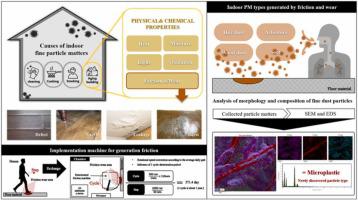Journal of Hazardous Materials ( IF 13.6 ) Pub Date : 2022-06-10 , DOI: 10.1016/j.jhazmat.2022.129290 Hyeonseong Yuk 1 , Ho Hyeon Jo 1 , Jihee Nam 1 , Young Uk Kim 1 , Sumin Kim 1

|
Particulate matter (PM), an inhalable material, is generated from various sources, including building materials. To maintain indoor air quality, it is necessary to analyze harmful substances and establish a method for their remediation. The purpose of this study is to identify the particles generated during the deterioration of building materials and analyze the composition of fine dust particles with respect to the degree of deterioration. The concentration of particles generated was analyzed using an SPS30 PM sensor in the built chamber. PM10 and PM2.5 levels of the maximum of 41.95 mg/m3 and 20.63 mg/m3, respectively, were generated from the tested building materials. The components of the collected PM were carbon, hydrogen, and silicon, among others, which are high-molecular-weight compounds. Particles of size 2.5 µm or less were detected, and the possibility of generating nanoplastics was investigated.
中文翻译:

微塑料:建筑材料变质产生的颗粒物(PM)
颗粒物 (PM) 是一种可吸入材料,其产生的来源多种多样,包括建筑材料。为保持室内空气质量,有必要对有害物质进行分析并建立其修复方法。本研究的目的是识别建筑材料劣化过程中产生的颗粒,并就劣化程度分析细粉尘颗粒的组成。使用内置室中的 SPS30 PM 传感器分析产生的颗粒浓度。PM10 和 PM2.5 水平最高分别为 41.95 mg/m 3和 20.63 mg/m 3,分别由测试的建筑材料产生。收集的 PM 的成分是碳、氢和硅等,它们是高分子量化合物。检测到 2.5 µm 或更小的颗粒,并研究了生成纳米塑料的可能性。



























 京公网安备 11010802027423号
京公网安备 11010802027423号